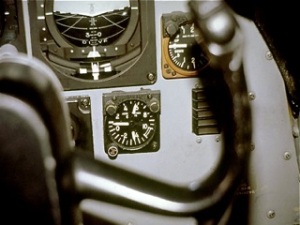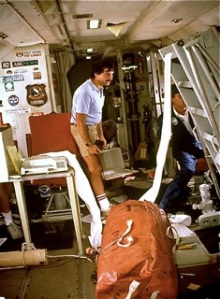NOAA 42 radar display of Hugo’s eyewall
On September 15, 1989, NOAA 42 “Kermit” flew a research mission into Hurricane Hugo, east of Barbados, that became what old-time Hurricane Hunters called a “hairy hop”. This referred to a hurricane flight where the turbulence was so severe as to put the mission in jeopardy.
The day before the two NOAA P-3 Orion research planes had deployed to Barbados to intercept Hugo while it was still east of the Lesser Antilles. In addition, several Air Force Reserve Hurricane Hunter C-130s had similarly deployed to carry out reconnaissance on the storm. The plan was for NOAA 42 to enter the storm first, followed by NOAA 43 “Miss Piggy” and the USAF aircraft, designated Teal 57. On approach to the storm there was a temporary outage of the lower fuselage radar, blinding the crew as to the structure and strength of the storm they were approaching. Jeff Masters, the Flight Director, and Frank Marks, the Lead Scientist, decide to enter the storm at 1500 feet, an altitude much lower than the usual 5-10 thousand feet. The hope was to gather energetics information close to the top of the boundary layer. However, since this was the first plane to enter this storm, the crew had no idea how strong the eyewall turbulence would be. Once the radar was working again, NOAA 42 was just minutes from penetrating the storm. The eye appears to be just 12 miles across.
NOAA 42’s G meter
They slammed into an updraft/downdraft/updraft triplet which wrenched the aircraft violently from 20 mph up, to 22 mph down, to 45 mph up again, all while the horizontal winds peak at 185 mph (298 km/hr)! Then force on the plane goes from 3 g’s downward to 6 g’s up (1 g = the force of gravity). Even items which were fastened down, such as a 200 pound life raft, are torn loose and sent careening around the cabin. Even worse, one of the aircraft’s four engines spouts flames. Just then they enter the calm of Hugo’s eye. The pilots pull the plane out of its dive 880 feet above the raging ocean surface, a loss of 620 feet in just seconds. To add to their predicament, the navigator Sean White spots a de-icing boot dangling loose over the engine next to the one on fire.
NOAA 42’s trashed interior
NOAA 42 begins to orbit the small eye of Hugo, desperately trying to avoid entering its fierce winds again. They hope to quell the engine blaze and then gain altitude to exit the storm at a safer altitude. The aircraft begins the tricky business of dumping excess fuel in order to lighten the plane and allowing it to climb further. They also eject all of the heavy bathythermograph probes they had on board to measure sea temperatures. After reaching 5000 feet, Teal 57 arrives in the eye and flies near NOAA 42 to inspect for damage. Finding nothing major, the Air Force plane begins a series of eyewall penetrations looking for a ‘soft spot’ for NOAA 42 to exit by. NOAA 43 arrives in the eye and monitors the other aircraft from 15,000 feet. When they are finally ready to exit, the crew finds that the dangling de-icing boot has fallen off without further injury to its engine. They follow Teal 57 out through the northeast eyewall, found to be the weakest spot, and exit the storm while encountering just manageable turbulence. They return to Barbados with no injuries.
But NOAA 42 is out of commission for the rest of the 1989 hurricane season. NOAA 43 continues to monitor the hurricane as it rampages through the Caribbean, kiling 72 people and racking up over US$4 billion in havoc, and finally makes landfall at Charleston, SC. HRD crews are at the Charleston and Wilmington NWS offices recorded the radar data for future research as the storm plowed through the Carolinas causing US$5 billion in damages and 35 deaths.
NOAA 42 crew on Sept. 15th : Aircraft Commander Lowell Genzlinger, Pilot Gerry McKim, Flight Director Jeff Masters, Flight Engineer Steve Wade, Navigator Sean White, Radio Operator Tom Nunn, System Engineers Al Goldstein and Terry Schricker, Radar Technician Neil Rain, Lead Scientist Frank Marks, Radar Scientist Peter Dodge, Doppler Radar Scientist Bob Burpee, Air-Sea Scientist Pete Black, Dropsonde Scientist Hugh Willoughby, Observer Jim McFadden, reporter Janice Griffith of the Barbados Sun.
Hurricane Hugo was a landmark storm in general and for researchers in particular. Some research papers by HRD personnel about Hugo:
- Black, M. L., R. W. Burpee, and F. D. Marks Jr., 1996: Vertical Motion Characteristics of Tropical Cyclones Determined with Airborne Doppler Radial Velocities. J. Atmos. Sci., 53, 1887–1909.
- Black, R. A., and J. Hallett, 1999: Electrification of the Hurricane. J. Atmos. Sci., 56, 2004–2028.
- DeMaria, M., and J. Kaplan, 1994: A Statistical Hurricane Intensity Prediction Scheme (SHIPS) for the Atlantic Basin. Wea. Forecasting, 9, 209–220.
- Demaria, M., and R. W. Jones, 1993: Optimization of a Hurricane Track Forecast Model with the Adjoint Model Equations. Mon. Wea. Rev., 121, 1730–1745.
- DeMaria, M., J. Kaplan, and J.-J. Baik, 1993: Upper-Level Eddy Angular Momentum Fluxes and Tropical Cyclone Intensity Change. J. Atmos. Sci., 50, 1133–1147.
- Dorst, N. M., 2007: The National Hurricane Research Project: 50 Years of Research, Rough Rides, and Name Changes. Bull. Amer. Meteor. Soc., 88, 1566–1588.
- Eastin, M. D., P. G. Black, and W. M. Gray, 2002: Flight-Level Thermodynamic Instrument Wetting Errors in Hurricanes. Part I: Observations. Mon. Wea. Rev., 130, 825–841.
- Franklin, J. L., S. E. Feuer, J. Kaplan, and S. D. Aberson, 1996: Tropical Cyclone Motion and Surrounding Flow Relationships: Searching for Beta Gyres in Omega Dropwindsonde Datasets. Mon. Wea. Rev., 124, 64–84.
- Franklin, J. L., and M. DeMaria, 1992: The Impact of Omega Dropwindsonde Observations on Barotropic Hurricane Track Forecasts. Mon. Wea. Rev., 120, 381–391.
- Gopalakrishnan, S. G., F. M. Jr., J. A. Zhang, X. Zhang, J.-W. Bao, and V. Tallapragada, 2013: A Study of the Impacts of Vertical Diffusion on the Structure and Intensity of the Tropical Cyclones Using the High-Resolution HWRF System. J. Atmos. Sci., 70, 524–541.
- Houston, S. H., W. A. Shaffer, M. D. Powell, and J. Chen, 1999: Comparisons of HRD and SLOSH Surface Wind Fields in Hurricanes: Implications for Storm Surge Modeling. Wea. Forecasting, 14, 671–686.
- Jones, R. W., and Mark DeMaria, 1999: Further Studies of the Optimization of a Hurricane Track Prediction Model Using the Adjoint Equations. Mon. Wea. Rev., 127, 1586–1598.
- Marks, F. D., P. G. Black, M. T. Montgomery and R. W. Burpee, 2008: Structure of the eye and eyewall of Hurricane Hugo (1989). Mon. Wea. Rev., 136, 1237–1259.
- Powell, M. D., P. P. Dodge, and M. L. Black, 1991: The landfall of Hurricane Hugo in the Carolinas: surface wind distribution. Wea. and Forecasting, 6, 379-399.
- Powell, M. D., 1993: Wind Measurement and Archival under the Automated Surface Observing System (ASOS): User Concerns and Opportunity for Improvement. Bull. Amer. Meteor. Soc., 74, 615–623.
- Powell, M. D., P. P. Dodge, and M. L. Black, 1991: The Landfall of Hurricane Hugo in the Carolinas: Surface Wind Distribution. Wea. Forecasting, 6, 379–399.
- Roux, F., and F. D. Marks Jr., 1996: Extended Velocity Track Display (EVTD): An Improved Processing Method for Doppler Radar Observations of Tropical Cyclones. J. Atmos. Oceanic Technol., 13, 875–899.
- Samsury, C. E., and E. J. Zipser, 1995: Secondary Wind Maxima in Hurricanes: Airflow and Relationship to Rainbands. Mon. Wea. Rev., 123, 3502–3517.
- Velden, C. S., C. M. Hayden, W. P. Menzel, J. L. Franklin, and J. S. Lynch, 1992: The Impact of Satellite-derived Winds on Numerical Hurricane Track Forecasting. Wea. Forecasting, 7, 107–118.
- Willoughby, H. E., R. W. R. Darling, and M. E. Rahn, 2006: Parametric Representation of the Primary Hurricane Vortex. Part II: A New Family of Sectionally Continuous Profiles. Mon. Wea. Rev., 134, 1102–1120.
- Willoughby, H. E., and M. E. Rahn, 2004: Parametric Representation of the Primary Hurricane Vortex. Part I: Observations and Evaluation of the Holland (1980) Model. Mon. Wea. Rev., 132, 3033–3048.
- Willoughby, H.E., 1998: Tropical Cyclone Eye Thermodynamics. Mon. Wea. Rev., 126, 3053–3067.
- Willoughby, H. E., 1991: Reply. J. Atmos. Sci., 48, 1209–1212.
- Zhang, J. A., F. D. Marks, M. T. Montgomery and S. Lorsolo, 2011: An estimation of turbulent characteristics in the low-level region of intense Hurricanes Allen (1980) and Hugo (1989). Mon. Wea. Rev., 139, 1447-1462.
- Zhang, J. A., and M. T. Montgomery, 2012: Observational Estimates of the Horizontal Eddy Diffusivity and Mixing Length in the Low-Level Region of Intense Hurricanes. J. Atmos. Sci., 69, 1306–1316.


